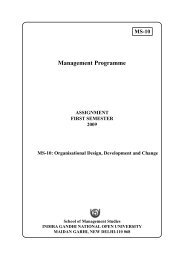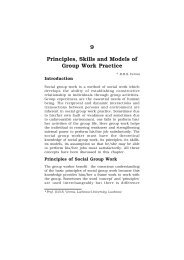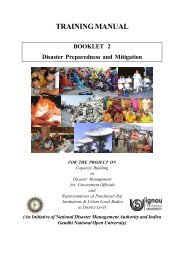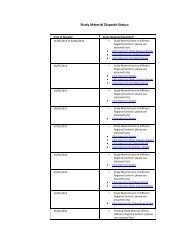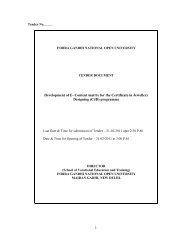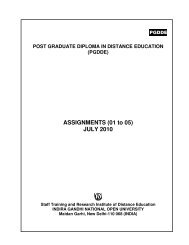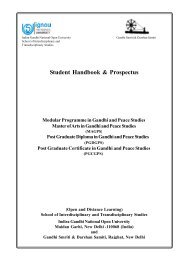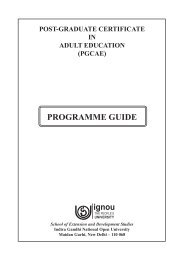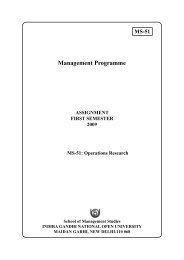Disaster Recovery and the Road Ahead - IGNOU
Disaster Recovery and the Road Ahead - IGNOU
Disaster Recovery and the Road Ahead - IGNOU
Create successful ePaper yourself
Turn your PDF publications into a flip-book with our unique Google optimized e-Paper software.
Utilizing <strong>the</strong> addition of clay <strong>and</strong> silt as fertlizers<br />
after levelling <strong>the</strong> ground.<br />
Introducing governmental policy for preventing<br />
human settlement in low-lying areas, <strong>and</strong><br />
encroachment on drains etc.<br />
Relocating of settlements to safer places.<br />
Long-term Reconstructive Measures would include:<br />
<br />
<br />
<br />
<br />
<br />
<br />
<br />
Building of safe houses <strong>and</strong> shelters in hazard prone<br />
areas<br />
Construction of houses on an elevated area<br />
Strict implementation of safety-codes in <strong>the</strong> construction of private <strong>and</strong> public houses <strong>and</strong><br />
buildings<br />
Construction of hazard-resistant roads, bridges, canals, water reservoirs, drinking water facilities,<br />
power transmission lines, telephone, cables, rail tracks, etc.<br />
Improvement in meteorological forecast <strong>and</strong> flood monitoring system, early warning system for<br />
cyclones, cyclone tracking system, etc.<br />
Construction of dams <strong>and</strong> embankments for protection against floods<br />
Organization of people to participate in preventive <strong>and</strong> protective measures, as well as to<br />
prepare for counter-disaster activities.<br />
DID YOU KNOW?<br />
People living in <strong>the</strong> cyclone/flood prone areas have been facing <strong>the</strong>se disasters at almost<br />
regular periodicity. As we have read in Booklet II, <strong>the</strong> local community has developed<br />
its own coping strategies to deal with <strong>the</strong> cyclones/floods. These can prove to be beneficial<br />
in minimizing <strong>the</strong> loss of life <strong>and</strong> property in <strong>the</strong> wake of <strong>the</strong>se calamities. Some of <strong>the</strong>m<br />
are as follows:<br />
<br />
<br />
<br />
<br />
<br />
<br />
Source: Earthquake/conservationtech.com<br />
People wrap all available seeds, rice paddy <strong>and</strong> bury it underground when <strong>the</strong>y move<br />
to safer places.<br />
Some families collect all <strong>the</strong>ir important papers, documents <strong>and</strong> o<strong>the</strong>r valuables <strong>and</strong><br />
bury it underground before leaving <strong>the</strong>ir houses.<br />
Houses are constructed on higher plinth, whereby <strong>the</strong> water cannot enter <strong>the</strong> house.<br />
If <strong>the</strong> clouds move towards north, <strong>the</strong>re is an indication that <strong>the</strong>re will be floods in<br />
three or four days.<br />
Some people while looking at <strong>the</strong> colour of <strong>the</strong> clouds <strong>and</strong> <strong>the</strong>ir formation can<br />
predict about floods.<br />
People grow banana trees around <strong>the</strong> houses as <strong>the</strong> banana stems are used for<br />
floating. Something similar to a boat is made out of banana stems <strong>and</strong> is used as<br />
barge or plank to keep afloat.<br />
34




